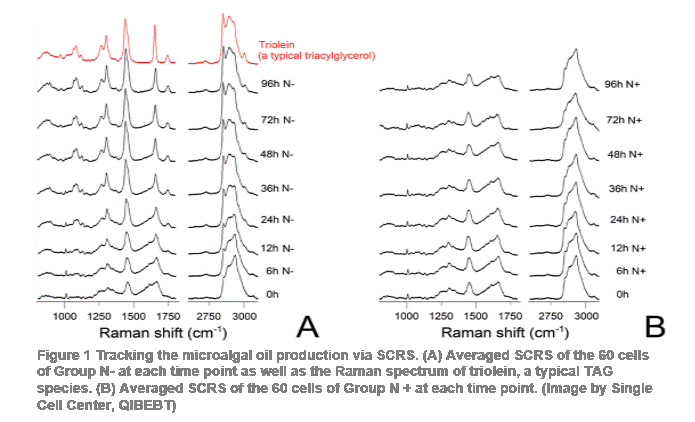Cellular heterogeneity that arises from stochastic expression of genes, proteins and metabolites is a fundamental principle of cell biology. However, mechanistic data are often masked in average values measured from heterogeneous populations. Although deterministic models for the prediction of average population network behavior have been successfully established, these models have usually failed to describe the cell-to-cell variation in functions.
A research team from Single Cell Center, Qingdao Institute of BioEnergy and Bioprocess Technology, Chinese Academy of Sciences (QIBEBT, CAS) has now established a novel approach for label-free measurement of cellular triacylglycerol (TAG) content at single-cell resolution by Raman microspectroscopy. Moreover they demonstrated the capability of the approach for monitoring the quantitative dynamics of TAG production in microalgae cells. The work is published in Biotechnology for Biofuels (Wang, Ji, et al, Biotechnol Biofuels, 2014).
TAG are the major energy-storage forms in most organisms on earth. In the human body, high levels of TAG in the bloodstream have been linked to atherosclerosis and higher risk of heart disease and stroke. In microalgae, TAG are the major components of algal oil, which is synthesized by the microalgae cells via photosynthetic CO2 fixation, and can be converted into biodiesels. Therefore, quantitative identification of cellular TAGs is of significance not only for screening of bioenergy feedstock, but also for early diagnosis of certain human diseases.
Sophisticated methodologies presently used for cellular lipid quantitation are usually invasive or even disruptive to the cells. Moreover they are time and labor consuming, and typically requiring a large amount of cells. More importantly, these methods mostly measured the average TAG contents of the cell population, leaving phenotypic variations among individual cells masked.

Employing the Raman-activated Cell Sorter (RACS) developed by the Center, Dr. WANG Tingting and JI Yuetong of Single-Cell Center, QIBEBT have shown that single-cell Raman spectra (SCRS) acquired within one second per cell can be used for label-free measurement of TAG content of live single microalgal cells. Application of this approach at eight time points during the cultivation of Nannochloropsis oceanica cells under nitrogen depletion revealed the quantitative dynamics of TAG accumulation in cells in a non-invasive and label-free manner (Figure 1). A significant negative correlation between TAG content and lipid unsaturation degree in individual microalgae cells, which was masked by population-level measurements, was now discovered. As quantification of cellular TAGs is widely practised in biotechnology and life sciences, this new single-cell technology should find applications in many areas that include medicine, pharmaceutical sciences, climate changes, food safety and ecology.
This research was supported by the National Basic Research Program (2012CB721101), the High-Tech Development Program (2012AA02A707), as well as the International Innovation Partnership Program from the Chinese Academy of Sciences. Prof. XU Jian and HUANG Wei of Single Cell Center, QIBEBT led the study, and Prof HU Qiang of Arizona State University also participated in this research.